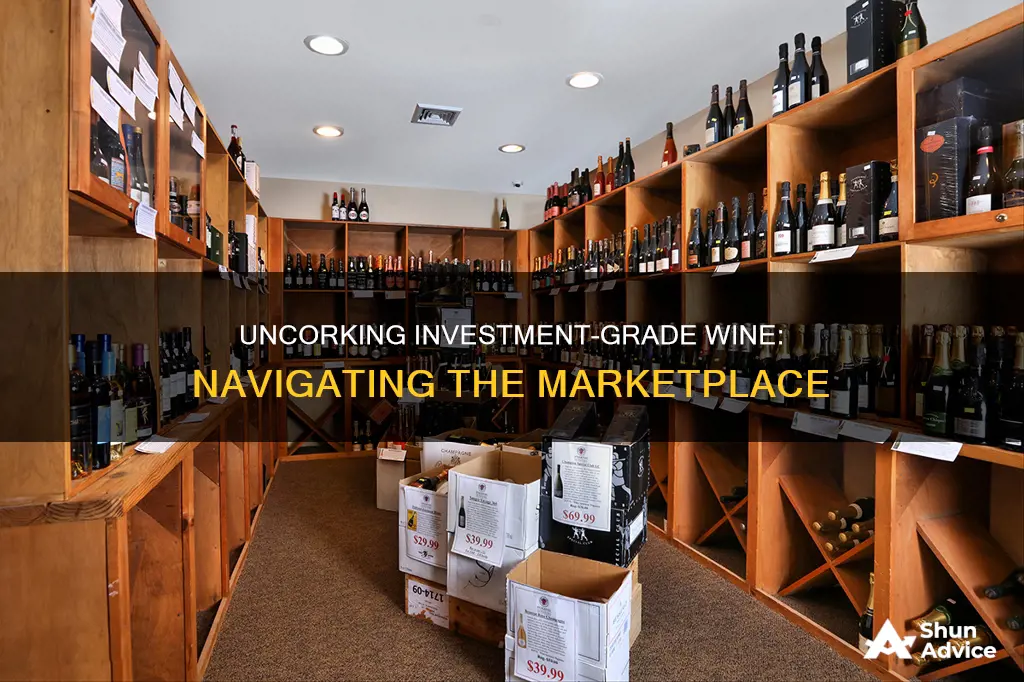
Wine investing is an alternative asset class that continues to gain popularity. Only a tiny fraction of wines, around 1%, are considered worthy of investment. These investment-grade wines are rare and exceptional bottles that attract collectors and investors on the secondary market. They are produced in limited quantities or sourced from prestigious vineyards known for their outstanding quality. The most popular regions for investment wines are Bordeaux, Burgundy, Champagne, Rhone Valley, Tuscany, Piedmont, California, Spain, and Australia.
When it comes to purchasing investment-grade wines, it is essential to consider several key factors. These include rarity, vintage, brand reputation, and condition. Older wines that have been aged properly tend to command higher prices, and wines with longer ageing potential, such as those from renowned regions like Bordeaux and Burgundy, are often sought after by investors. Well-established brands with a history of producing exceptional wines, such as Château Margaux and Domaine de la Romanée-Conti, are also highly desirable.
It is crucial to carefully research and source investment-grade wines to avoid issues like counterfeits or improper storage conditions. Partnering with professionals in the field can provide access to expertise and a diversified portfolio of securitized offerings.
| Characteristics | Values |
|---|---|
| Scarcity | Only 1% of wines are considered worthy of investment. |
| Demand | Demand is driven by critic scores, awards, and branding. |
| Price appreciation | Depends on factors such as annual harvest yields and tariffs. |
| Ageability | Investment-grade wines can be stored for 20-40+ years and will improve with age. |
| Region | Bordeaux, Burgundy, Champagne, Rhone Valley, Tuscany, Piedmont, California, Australia, and more. |
| Producers | Château Lafite Rothschild, Château Margaux, Screaming Eagle, Dom Pérignon, Penfolds, and more. |
What You'll Learn

Bordeaux Investment Wines
Bordeaux wine investments have traditionally focused on First-growth Bordeaux red blends. These wines have long-established reputations for reliable quality and aging potential, so there is always demand for them in the secondary market.
On Bordeaux's 'left bank', chateaux Latour, Lafite-Rothschild, Margaux, Mouton-Rothschild, and Haut-Brion remain reliable as high-grade investment wines. Across the Garonne in the Libournais (the 'right bank'), plush Merlot-based wines from Pomerol properties Le Pin, Petrus, Lafleur, and La Fleur-Petrus are particularly popular on the US fine wine market.
Bordeaux's first growths dominate lists of the most sought-after wines in the world. According to Wine-Searcher.com, this hallowed quintet accounts for five of the ten most searched-for wines on its platform.
Bordeaux wine investments have traditionally centred on classed-growth red Bordeaux (those of the 1855 Classification) from highly-rated vintages. These wines have a long-established secondary market and have built up good reputations for consistent quality and cellaring potential.
Bordeaux wines from renowned producers such as Château Margaux have long been a consistent part of the typical wine investing portfolio for decades. The Rothschild family’s flagship Lafite Rothschild Bordeaux blend, for example, has been a staple of wine investment portfolios for decades.
Bordeaux wines are also sought after by wine investors due to their longer ageing potential, with wines from this region developing complex flavours and aromas over time.
When it comes to investing in Bordeaux wines, it's important to consider the vintage, as not all years are the same. Weather, harvest, and a little bit of luck can impact the quality of the wine. Older wines that have been aged properly tend to command higher prices.
In addition to the wine itself, the reputation of the winery or vineyard also plays a crucial role in the investment potential of Bordeaux wines. Well-established brands with a history of producing exceptional wines are particularly attractive to investors.
The condition of the wine is another important factor. Wines that have been stored under optimal conditions, such as controlled temperature and humidity, will retain their quality and value over time.
Songs: The New Investment Avenue
You may want to see also

Burgundy Investment Wines
Burgundy is the market leader when measured by average trade price. The region's elite wines command the highest entry point into wine investment and deliver the most impressive returns. Burgundy can be the "Holy Grail" of wine investments, and high-profile auction sales have seen single bottles of rare vintages sell for nearly US$500,000.
The Grand Crus of the Cote de Nuits region, and particularly the Vosne-Romanée village, are the most highly regarded investment wines. The very small supply of Burgundy's highly sought-after Grand Crus is tightly controlled and can achieve significant prices, with rare older vintages routinely selling for six-figure sums.
The top-ranking Burgundy appellations, the grand crus, account for just 2% of Burgundy's total wine-producing area and command the highest prices. Some of the most prominent grand crus include Romanee Conti, Musigny, Richebourg and Clos Vougeot. Another 15% of land is formed of appellations of the next ranks - premier cru – some of the wines of which perform particularly strongly and may be considered investment grade, such as Henri Jayer Cros Parantoux.
The finest Burgundy wines are made only in tiny quantities, which are snapped up by Burgundy enthusiasts on release. When they re-appear on the market, their scarcity can drive prices to astronomical heights. The best investment wines from Burgundy are the Grand Cru wines from domaines de la Romanée-Conti, Henri Jayer, Comte Georges de Vogue, Georges Roumier, Armand Rousseau, Leflaive, Leroy, Meo-Camuzet and Coche-Dury.
The Investiture: A Historic Ceremony for King Charles III
You may want to see also

Rhone Valley Investment Wines
The Rhone Valley, located in southeastern France, is a renowned wine-growing region known for its diverse micro-terroirs and a wide range of climates and terroirs. The region boasts a long history of winemaking, dating back to the ancient Greeks and Romans, and is known for its rustic and traditional Syrah-based reds from the Northern Rhone and Grenache-heavy wines from the Southern Rhone.
When it comes to investment-grade wines from the Rhone Valley, there are several options to consider:
Jean-Louis Chave
The wines of Jean-Louis Chave are considered some of the most attractive investment prospects from the region. The Cuvee Cathelin and Vin de Paille are particularly sought-after, with the former having shown substantial appreciation in value over the years.
Paul Jaboulet's Hermitage La Chapelle
This wine is another excellent investment option from the Rhone Valley. It is produced by the renowned winemaker Paul Jaboulet and is known for its exceptional quality.
Guigal's Hermitage Ex Voto and 'La-La' Wines
Guigal's Hermitage Ex Voto is a highly regarded investment-grade wine from the Rhone Valley. In addition, Guigal also produces the sought-after 'La-La' wines: La Landonne, La Turque, and La Mouline. These wines have consistently increased in value over the years and are considered benchmark Syrah wines.
Chateau de Beaucastel's Hommage à Jacques Perrin
This wine is a top-end Chateauneuf-du-Pape wine that is highly sought-after by collectors and enthusiasts. Chateau de Beaucastel is a well-known producer in the region, and their wines are known for their exceptional quality.
Chateau Rayas Chateauneuf-du-Pape
The Chateau Rayas winery produces a range of investment-grade wines, including the standard Réserve, the Pignan Réserve, and the Réserve Blanc. These wines have a long history and are known for their complex flavours and ageing potential.
M. Chapoutier: Le Pavillon 2015
This wine from the renowned producer M. Chapoutier is another excellent investment option from the Rhone Valley. It has received accolades and is known for its exceptional quality.
Domaine de Beaurenard: Boisrenard 2020
This Chateauneuf-du-Pape wine from Domaine de Beaurenard is an excellent investment prospect. It showcases the traditional winemaking style of the region and is available for pick-up at select stores.
Chateau de Saint Cosme: Chateauneuf-du-Pape 2020
This Chateauneuf-du-Pape wine from Chateau de Saint Cosme is another excellent investment option. It is known for its rich, complex flavours and is available for pick-up at select stores.
Domaine Guillaume Gilles: Cornas 2018
This Cornas wine from Domaine Guillaume Gilles is a fantastic investment-grade wine. Cornas is a prestigious appellation known for its spicy, chocolatey, and earthy styles, and this wine showcases the best of the region.
E. Guigal: La Landonne and La Mouline
These wines from E. Guigal are excellent investment prospects. La Landonne, in particular, has shown consistent growth in value, and both wines are available for pick-up at select stores.
In addition to these options, the Rhone Valley offers a range of other investment-grade wines, including those from producers such as Domaine du Pegau, Domaine de Saint Siffrein, and Domaine Duseigneur. The region's wines are known for their ageing potential, complex flavours, and ability to pair with a wide variety of dishes.
Smart Ways to Invest $15,000
You may want to see also

Champagne Investment Wines
Champagne is currently the top-performing region for investment wines, averaging 40.8% growth over five years, outperforming the FTSE 100's 10% rise in the same period. Champagne's brand power, vast production, and highly efficient global distribution network have positioned its primary export as an aspirational, luxury product. The most valuable investment wines are globally recognised luxury brands with a rich heritage of winemaking excellence spanning generations.
Champagne's typical performance is strong, stable growth. Compared with the general trend of other wine investment regions, Champagne investments enjoy the greatest stability due to the much larger supply when a vintage is first released. Over time, as a vintage becomes rarer, demand drives sustained price growth. Champagne data from the Liv-ex Champagne 50 shows that it has been the top-performing regional index in recent years.
When it comes to Champagne investment wines, wine investors should consider the 'prestige cuvees' and rarest wines of the following Grand Marques Champagne producers:
- Louis Roederer, Cristal
- Moet & Chandon, Dom Perignon
- Pol Roger, Sir Winston Churchill
- Salon Le Mesnil-sur-Oger
- Taittinger Comtes des Champagne
Champagne is the most famous wine-growing region in the world, as the source of the greatest sparkling wines, and this reputation is enhanced by the brilliant marketing of the iconic Champagne houses, whose 'luxury' brands have global recognition. The Champagne growing region extends across 30,000 hectares from Charly, just 50 km east of Paris in the Marne Valley, and spreads north to Reims and south to Epernay. It is the only vine-growing region to have just one appellation, with the very best vineyards sited on the chalky hills.
The three main grape types planted in Champagne are Pinot Noir, which provides structure and depth; Pinot Meunier, which delivers early-maturing richness; and Chardonnay, which imparts austerity and elegance and is long-lived, maturing to a fine fruitiness.
Champagne investment requires a detailed understanding of the market, including knowledge of the vineyards, the producers, the vintages, and the market trends. It is also important to consider the costs and considerations of building and maintaining a wine collection, such as taxes, shipping costs, storage options, and insurance.
The RRSP Dilemma: Investing for the Future or Paying Off Debt?
You may want to see also

Italian Investment Wines
Italian wines have been rising in popularity as investment options, with a 112% increase in the number of Italian wines on the Liv-ex classification between 2019 and 2022. This text will explore some of the top Italian investment wines and the regions they come from.
Regions
The top Italian investment wines come from two main regions: Tuscany and Piedmont.
Tuscany
Tuscany is home to the famous Super Tuscans, which have gained traction in the investment market. These include:
- Sassicaia: the most traded Italian wine in 2021, with a spectacular 40% increase in value between February and March 2022.
- Ornellaia
- Solaia
- Brunellos from Gianfranco Soldera or Casanova di Neri
- Vino Nobile classics like Poliziano Le Caggiole or Avignonesi Riserva Grandi Annate
Piedmont
Piedmont wines are growing in market share by value, with an increase in popularity in 2021. Barolos and Barbarescos from Piedmont are excellent options for investment, including:
- Barolos such as Giacomo Conterno's Monfortino and Cascina Francia, the Monprivato wines of Giuseppe Mascarello and Bartolo Mascarello, and Aldo Conterno's Granbussia
- Barbaresco: two Roagna I Paglieri wines (Crichët Pajé and Pajé Riserva) and the Gallina and Albesani Santo Stefano by Bruno Giacosa
Other Regions
While Tuscany and Piedmont are the main players, investors should also consider smaller producers from other regions such as Umbria, Abruzzo, and Veneto when diversifying their portfolios.
Tips for Investing in Italian Wines
When investing in Italian wines, it is important to consider the following:
- Longevity: While some Italian wines have proven longevity, there may be more caution around the longevity of wines from smaller producers.
- Supply and Demand: A vintage with a higher-than-average score for its region is termed ‘Prime’ and can add a price premium. However, highly-scored wines from mid or off vintages may also offer strong potential for growth.
- Storage: Ensure that the wine is stored properly to maintain its quality and increase its value over time. This includes keeping it away from direct sunlight and heat sources, and controlling temperature and humidity.
In conclusion, Italian investment wines offer a great opportunity to diversify your portfolio, with a range of options from the famous Super Tuscans to the elegant Barolos of Piedmont.
Morningstar's Guide for Senior Investors
You may want to see also
Frequently asked questions
Investment-grade wine can be purchased from various platforms, such as Vinovest, Sokolin Fine and Rare Wines, and Vin-X. You can also refer to resources like the Liv-ex Power 100 report, which lists the top 100 fine wine labels in the secondary market.
Popular regions for investment-grade wines include Bordeaux, Burgundy, Champagne, Rhone Valley, Tuscany, Piedmont, California, Spain, and Australia.
Well-known brands of investment-grade wines include Château Lafite Rothschild, Domaine de la Romanée-Conti, Screaming Eagle, Dom Pérignon, Louis Roederer, Krug, Sassicaia, Ornellaia, Solaia, and Penfolds.
The key factors that make a wine investment-grade include scarcity, high demand, price appreciation, and ageability. Wines from prestigious vineyards with limited production and exceptional quality are often sought-after by collectors and investors.







